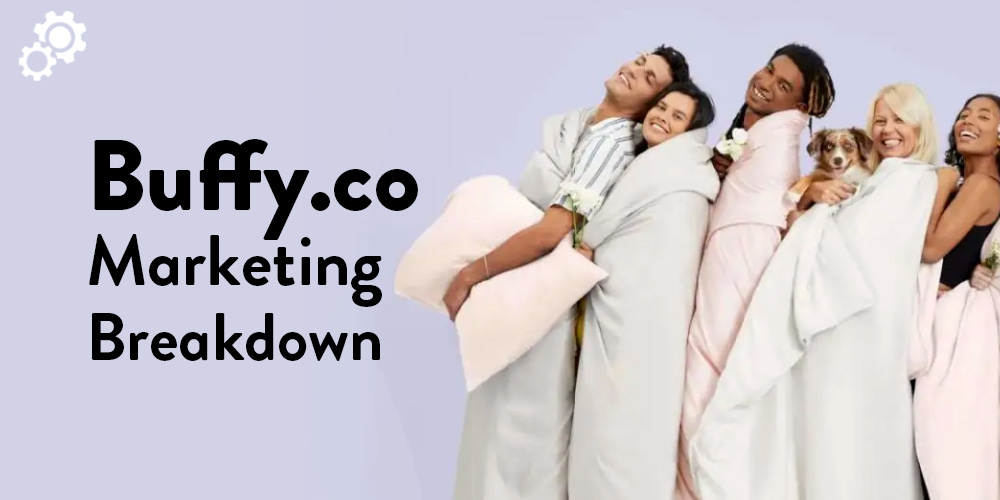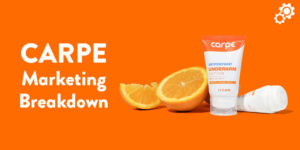“About 30 million comforters are sold each year, and that’s just in the United States.”
That was Leo Wang, co-founder and CEO of Buffy, a bedding company founded back in 2017 in New York.
Buffy is to bedding kind of like Away is to travel. The founders saw there was a category that had no leading brand and decided to build it. And they did a damn fine job with it.
Naturally, I was curious to see what was under the hood. I wanted to see what marketing tactics and strategies the Buffy team deployed to build the brand.
Summary of marketing tactics:
- Buy now, pay later
- Fun brand powered by a mission
- Instagram story highlights to introduce the brand
- Boost AOV with bundle packs
- Boost CLV with strategic product launches
- Build custom landing pages for paid traffic
Let’s get into the marketing breakdown.
1. Buy now, pay later
We begin with the most powerful marketing strategy in Buffy’s arsenal – completely eliminating all friction points for completing a transaction by letting shoppers get it for free (kind of).
You don’t see many D2C brands doing this (yet), but Buffy does it well –

How does it work? From their site:
“Our 7 night free trial lets you sleep with our products before you commit to buying—like a test drive for your bed! To make sure your payment method is valid and can be charged once the trial period is over, a temporary hold will be placed on your card, which may appear as “pending” or “processing.”
So why is this so effective?
Imagine how you’ve shopped for comforters (or any sort of bedding) in retail stores. You would walk around the store, you’d stop to touch the comforter, squeeze it, put it close to your face and snuggle with it.
You want to feel the comforter before you bring it home.
Well, that’s difficult to do when you’re shopping online.
In the early stages of the business, as part of their customer research the Buffy team would show up at pop-ups with 6-7 different comforters so customers could touch them and feel them.
“People would walk by, put their hand on the comforter, and stop immediately and say “wow this is so soft and fluffy” .. they’d put it against their body.”
– co-founder Shoaib Kabani on a podcast interview
They needed to figure out a way to get the comforter to as many people as possible.
An initial test of a risk-free trial – 100 nights to try the comforter – didn’t lift conversions, so they swapped their offer to a ‘try it at home’ offer .. and things clicked.
Buffy lets you purchase the comforter for $0 (they’ll put a hold on your card), ship it to you, and let you try it for 7 nights. That’s where you can touch it, squeeze it, and snuggle with it. It’s not exactly the same as the retail experience, but you can understand why it’s so effective.
This isn’t as much about the delayed purchase as it is about the psychology of it.
Most brands (if not all at this point) offer some sort return policy or guarantee, which effectively works the same way – you purchase the product, try it for a period of time, and if you don’t like it you return it and get your money back.
But when you see zero dollars at checkout, it feels different –

Now there are some technical challenges with this approach as it pertains to fraud protection. The team at Buffy had to build some robust fraud protection in the back-end to protect themselves. They hired a sophisticated engineering team to limit fraud and non-bill throughs and spent lots of time building a custom payments app that connects to Shopify.
But the idea here isn’t as much about figuring out how to offer a home trial for your consumers.
The goal is to figure out how you can minimize the friction points for your consumer. It’s similar to The Sill’s one-click checkout test. You want to make it a no brainer decision for your customer to try your product.
Your key takeaways:
- Think about how you can give your customers an opportunity to try your product before committing. This is particularly important if your key differentiators need to be felt and experienced.
- Think about what return policy you can put in place to remove any friction points and objections for your shoppers. Make sure you’re considering the psychology of how you’re framing the offer.
2. Fun brand powered by a mission
Buffy has been mission-driven from the outset. Here’s a quote from Mic.com –
“What sets Buffy the brand apart from many other bed-focused brands is first its values. Buffy prides itself on being sustainable — with comforter filling made from recycled plastic bottles — in addition to being allergen-free, cruelty-free and as thoughtful as possible when it comes to waste. For the outer layer of its comforters, for instance, Buffy uses natural eucalyptus fibers, which require 10 times less water to cultivate than cotton.”
Source: Mic
They set out to create a product (and brand) that was better for their customers and better for the Earth.

Why is this important?
Well apart from saving geese and making the Earth a better place, it essentially drives everything they do at the company. With every new product launch, they look to bring the same brand values.
They’ve also found a way to put a fun spin on their brand, with bright colors, bubbly fonts, and complete ignorance for proper capitalization (which I love). When we typically think about sustainability, it conjures up serious tones and imagery about climate change.
By making sustainability feel fun, Buffy makes their purpose stand out.
Your key takeaways:
- Look back at your purpose / mission and think about how your decisions around marketing, product development, and overall strategy tie back to your mission.
- If you don’t have your mission laid out, watch this video.
3. Instagram story highlights to introduce the brand
In the direct to consumer space, consumers often get introduced to brands on social media platforms. These are discovery platforms, after all.
If I see an ad in my feed, I’ll often visit the brand’s page on that social platform before I visit the website. Buffy has thought about this journey and they’re using their Instagram story highlights to introduce people to their brand –

Whether you run paid social ads or not, add Instagram story highlights on your Instagram channel so that those who are just discovering your brand can see what it’s all about.
Your key takeaways:
- Add a ‘Meet [your brand]’ story highlight on your Instagram profile.
- Think about how you’re structuring your highlights based on what’s important to your customer.
4. Boost AOV with bundle packs
This is a unique play as I haven’t seen anything similar on other sites.
Buffy offers what they call a bundle pack (note – this is a hidden product at the time I’m seeing it, but it may or may not be live when you’re trying the link). It’s a built-in quiz like interface that allows you to add multiple complimentary products to your cart all in one go.
Here’s what it looks like –

I absolutely love this. The Buffy team is clearly ahead of the game when it comes to bundle strategies. This visual approach to bundling allows users to personalize their entire bedding pack which does wonders for AOV.
And you can see how beautifully it ties into the first strategy where you see $0 at the last step. We’ll see how it develops from here.
Your key takeaways:
- While you don’t need to develop your own bundling pack tool, think about how you can bundle your product offerings – what products make sense to go together? What products complement each other? Consider testing to see how it affects your AOV.
- If you’re not using order bumps on your product pages, look into one of the many order bump Shopify plugins which are great for boosting AOV.
5. Boost CLV with strategic product launches
A comforter is a product you’re likely to purchase only once from a brand. This creates challenges when it comes to boosting repeat purchase rate and customer lifetime value.
So the first place the Buffy team started is exactly where you’d think.
They got their customers to buy a second comforter for another room in their house or as a gift for a friend. Of course, you can only have success with this if you have a high quality product, deliver a great customer experience, and perhaps offer a special discount to create incentive.
Next up, Buffy flexed their product launch strategy and identified both complementary products and alternative products their customers would want to buy.
On the complementary product side, the duvet cover was a great place to start (since 50% of the population uses a duvet cover) and an easy plug-n-play post purchase.
On the alternative product side, they realized they had an opportunity to launch a different type of comforter that was more conducive to the warmer summer months. And so they came up with their Breeze temperature-regulating comforter during the summer season.

You can tell they spend a lot of time thinking through their product and development strategy and what products their customers would want the most which does wonders for customer lifetime value.
If you’re looking to launch a new product offering or new brand, here’s a bonus tip: product reviews are a gold-mine. This was the route the Buffy team took at the outset –
“The goal was to start with a category that people ignored. [At the time], the comforter market was smaller than sheets and mattresses – around $5B. But reviews for comforters on average were very low and customers weren’t happy with the materials. We felt many other DTC bedding companies were ignoring comforters. [We] wanted to build a relationship with our customers for future product launches.“
– Shoaib in podcast
The roadmap Buffy used is straightforward:
- Find a product category where customers are generally unhappy (low reviews) that has been ignored
- Create an outstanding product that delivers value to that customer base
- Build a relationship with that customer
- Expand into different product categories that are more crowded with your values intact
Your key takeaways:
- If you have a product that is generally a one-time purchase, think about why your customers would want to buy a second or third purchase – would it make a great gift, can they use it in different locations, etc.
- Think about what complementary products you can add to your catalogue that would be no-brainer additions for your customers.
6. Build custom landing pages for paid traffic
Most brands run all their paid social ads to their homepage. It’s a great (and easy) place to start and most often works quite well. That’s where the Buffy team started too.
But driving their paid traffic to custom landing pages was a game-changer for them.
“Implementing LPs (landing pages) was game-changing for us. Prior to that we would send all traffic to the homepage and there was just one flow people would take. Moving traffic to landing pages made our ads more efficient as we were able to match the offer on the ads to the message on the landing page (creative, product attributes, etc.).”
Source: Shoiab on the Ecommerce Influence podcast
To build and test their landing page variations, Buffy uses a landing page builder tool called Instapage. They drive traffic to a landing page built via Instapage and hosted on a subdomain.
To show an example, here are two ads they’re running –

And then here are two variations of their landing page they use:
https://meet.buffy.co/home
https://meet.buffy.co/hp/home
Note – these links may change at the time of reading; they test a lot.
You can see how they’re testing different hero messaging and imagery and product order. You don’t want to have too many things different otherwise you won’t know what’s actually driving performance. The hero section (headline and imagery) are the best place to start.
Your key takeaways:
- If you’ve been running all of your traffic to your homepage, consider creating a landing page that is a variation of your homepage and split your traffic 50/50 for each and watch your key metrics. You can also create and test a bridge page (learn more about them from my Harry’s breakdown).
- If you want to analyze where other brands are sending their traffic to, use Facebook’s Ad Library to view a brand’s ads library (you can see Buffy’s ads library here). Hover over each ad to see which URL the traffic is being sent to.
Buffy Marketing Summary
Buffy has done a fantastic job identifying a category that desperately needed a disruptor and has utilized a unique collection of marketing strategies and tactics to fuel their growth.
As always, these are just a handful of the tactics that stood out to me, but there are plenty of others – their beautiful emails, overall simple PDP layouts, their fun ads and cute utilization of emojis in ad copy, and more.
Feel free to dig around and see what you find and, more importantly, identify the tactics you want to bring back to your own team.
Enjoyed this post? Sign up below to get notified when a new breakdown goes live –
✌




